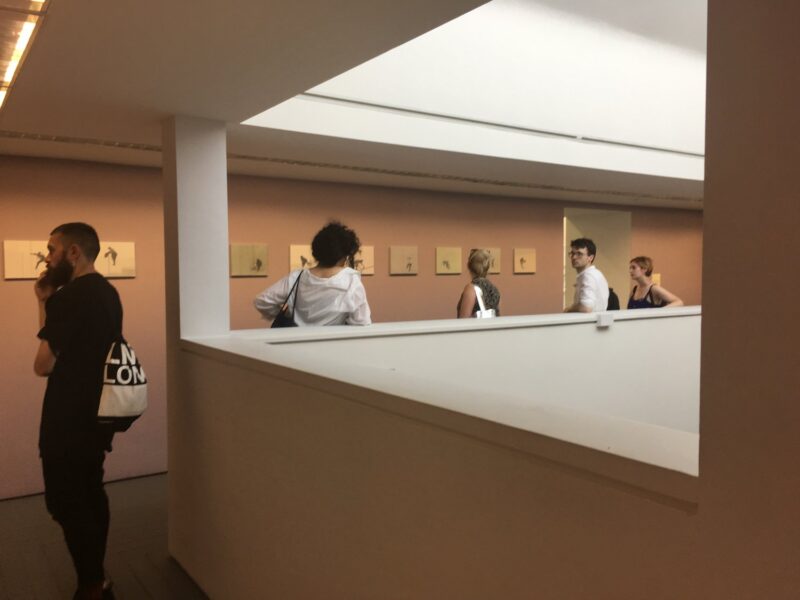Many adjectives can be applied to art: clever, moving, sad, innovative, political. However, art is not required to be any of these things. Art is required to possess possibility, which must be derived from dialogue. The Douglas Hyde Gallery’s Student Forum forges space for such conversations.
Now in its third year, the forum consists of a selected group of students and recent graduates who engage with the gallery over a 12-month period, each bringing their own research and artistic practices with them. Fernando Sanchez is the learning and engagement curator of the gallery and leads forum discussions. In conversation with The University Times, he explains that his role “as well as preparing, searching and creating events, is about devising engagement with different elements of the gallery”. The goal of the forum is simple, he says: to create “a space for students interested in art to come together, and converse”.
Sanchez’s role is to “give people the tools to access art”. He emphasises that this involves entry points of experience, as well as those of knowledge: “The forum urges students to see how different people engage with art in different ways.” The curator also explains that students from any university in Ireland can apply to partake in the forum: “We consist of a range of people doing sociology, to environmental studies, to those studying in NCAD.”
Sanchez adds that the role of the forum is not to encourage its members to be like those “perceived to exist in the art world”, but rather, to embrace the ingenuities that continually arise as subversions of established narratives. He stresses that participants “must try and get more of a dialogue going between the gallery, the public and the university”. He believes that “art should serve as a unifying force in this regard”.
Holly Moore is a final-year Trinity student, and current member of the forum, who hopes to bring “scepticism” to forum discussion. When asked what compelled her to sign up, Moore reflects upon a curious sign she saw in the window of the Douglas Hyde, which posed “interlocking questions, like: how long can a culture persist without the new? And where does the epistolary lie on your to-do list?”. Upon discovering that these questions related to an online magazine made by previous forum students, Moore applied “for fun really” and also because she finds “art galleries strange and intimidating”. In conversation with The University Times, Moore explains that the group meets monthly for discussions of readings, and will be producing artwork for an end of year project. “These projects are united by the intention to consider the gallery as a philosophically and sociologically produced space.”
To encourage students to identify and consider barriers into the art world, Sanchez explains that the group “have been looking at the gallery space, but from the point of view of exclusion, inclusion and participation”. He sees it as his role “to reach out to society and to see what kinds of collaboration and projects we can do and create together”. He pauses for momentary reflection before asking: “When you go to a gallery, is the language accessible for someone who doesn’t know anything about contemporary art? How can we resolve this?” Sanchez explains that by selecting one mode of accessibility, we are sacrificing, or “excluding” another. “That’s the simple nature of it – it is hard to cover everything in a gallery space, but we bring awareness to these limitations in discussion.” The whole idea of the programme, he says, “is to think about who we are including and reflecting on our choices”.
Sanchez is from Spain, “where visual art has a long tradition” and “is seen as an equal to literature, theatre and music”. “Ireland encountered contemporary art later than other countries”, he points out, noting that “the IMMA was not founded until 1991, for example”. The curator emphasises the fallacy of understanding between Irish audiences and art: “Galleries are central spaces for shaping societies – some people go to an art gallery to relax, some to educate themselves, some to see a space where enquiry is encountered.” According to him, these differences don’t matter: “Art is useful for everyone and is about difference.”
The forum acknowledges that art has a branding and outreach problem, which it explores by encouraging students who are used to a sleepier, insular art world to interrogate what they are experiencing. Indeed, Moore finds it “refreshing to talk to people who haven’t got the same background as [her] in art history”. She asserts that there are many kinds of art educations: “From being encouraged to look and see, to being uncritically indoctrinated with the Western canon of art”. Continuing, she points out that “we don’t live in an ideology-less society”, and so, “it’s no coincidence that people have written about the visual similarities between ‘white cube’ art galleries and the displays of department stores”. For Moore, it’s important to ask what the educator’s agenda is: “Like lots of other people, I wish there had been more art education, in a broad sense, in my Irish school education.”
The Douglas Hyde Student Forum is helping to evolve art education from strictly a teaching tool, into an exploratory experience. As the students investigate different perceptions of the world, they become more inventive thinkers. As Sanchez concludes, this interface is “an incredible way to spread ideas and to engage with social issues”. Art is at the centre of many things, and, through discussion, the Douglas Hyde Student Forum shows that aesthetic judgement is also cultural evaluation.






